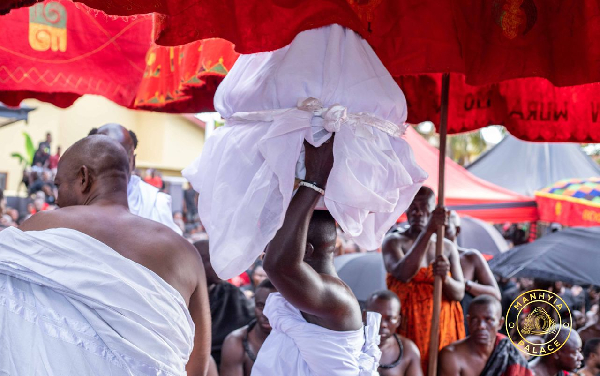- Amid the sea of black and red mourning cloth at Nana Konadu Yiadom III’s burial, a striking group in white drew attention.
- These were the official priests of Tepa, custodians of the sacred deity Tepa Barnie, whose presence signals deep spiritual significance.
- Tepa priests traditionally wear white kente and carry white umbrellas, a sign that Otumfuo Osei Tutu II will attend the ceremony.
- Children dressed in white who greeted Otumfuo are known as “children of Barnie,” born through divine intervention after families prayed to the deity.
- These children often bear a unique birthmark—a patch of white hair—symbolizing their spiritual origin.
- The presence of both priests and children reflects the enduring bond between Asanteman’s royal leadership and its ancestral deities.
At the final funeral rites of the late Asantehemaa, Nana Konadu Yiadom III, tradition was everywhere—etched in cloth, echoed in drums, and embodied in ritual. But one group stood apart. While mourners filled Manhyia in black and red Kuntunkuni, a cluster of figures in radiant white moved quietly through the crowd. Their presence wasn’t a fashion statement—it was a spiritual declaration.
These were the official priests of Tepa, guardians of the revered deity Tepa Barnie. In Asante tradition, their white attire and signature white umbrellas are not optional—they are sacred. Their appearance at any durbar signals that Otumfuo Osei Tutu II will be present, and their role is deeply intertwined with the spiritual order of the kingdom.
The Tepamanhene, who serves as chief priest of Barnie, leads this group. He does not dance or perform theatrics. His presence is ceremonial, his attire symbolic. The tendrils of tradition run deep, and in moments of royal mourning, they surface with clarity.
Also present were children dressed in white—another rare sight. These are known as “children of Barnie,” born to families who sought divine intervention from the deity after struggling with infertility. Each child carries a unique mark: a patch of white hair on the head, believed to be the signature of Barnie’s blessing.
When Otumfuo is seated and Barnie is invoked, these children are allowed to greet the king—a gesture reserved for those with spiritual lineage. Their presence at the Asantehemaa’s burial was not just ceremonial; it was a living testament to the power of belief and the continuity of tradition.
As Nana Konadu Yiadom III was laid to rest, the white garments of Barnie’s priests and children reminded Asanteman that mourning is not only about loss—it is also about legacy, lineage, and the sacred forces that bind the kingdom together.
Watch video;
The deity of Tepa is called “Tepa Barnie”.. if you consult him for a child, he will give the child a birth mark… All children given by the deity have the same birth mark… pic.twitter.com/1OjtSVr5zR
— KWA_KU_ (@kurowura2) September 18, 2025



